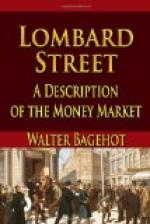The rise of prices is quickest in an improving state of credit. Prices in general are mostly determined by wholesale transactions. The retail dealer adds a percentage to the wholesale prices, not, of course, always the same percentage, but still mostly the same. Given the wholesale price of most articles, you can commonly tell their retail price. Now wholesale transactions are commonly not cash transactions, but bill transactions. The duration of the bill varies with the custom of the trade; it may be two, three months, or six weeks, but there is always a bill. Times of credit mean times in which the bills of many people are taken readily; times of bad credit, times when the bills of much fewer people are taken, and even of those suspiciously. In times of good credit there are a great number of strong purchasers, and in times of bad credit only a smaller number of weak ones; and, therefore, years of improving credit, if there be no disturbing cause, are years of rising price, and years of decaying credit, years of falling price.
This is the meaning of the saying ’John Bull can stand many things, but he cannot stand two per cent:’ it means that the greatest effect of the three great causes is nearly peculiar to England; here, and here almost alone, the excess of savings over investments is deposited in banks; here, and here only, is it made use of so as to affect trade at large; here, and here only, are prices gravely affected. In these circumstances, a low rate of interest, long protracted, is equivalent to a total depreciation of the precious metals. In his book on the effect of the great gold discoveries, Professor Jevons showed, and so far as I know, was the first to show, the necessity of eliminating these temporary changes of value in gold before you could judge properly of the permanent depreciation. He proved, that in the years preceding both 1847 and 1857 there was a general rise of prices; and in the years succeeding these years, a great fall. The same might be shown of the years before and after 866, mutatis mutandis.
And at the present moment we have a still more remarkable example, which was thus analysed in the Economist of the 30th December, 1871, in an article which I venture to quote as a whole:
’The great rise in the price of commodities.
’Most persons are aware that the trade of the country is in a state of great activity. All the usual tests indicate that—the state of the Revenue, the Bankers’ Clearing-house figures, the returns of exports and imports are all plain, and all speak the same language. But few have, we think, considered one most remarkable feature of the present time, or have sufficiently examined its consequences. That feature is the great rise in the price of most of the leading articles of trade during the past year. We give at the foot of this paper a list of articles, comprising most first-rate articles of commerce, and it will be seen that the rise of price, though not universal and not uniform, is nevertheless very striking and very general. The most remarkable cases are—




